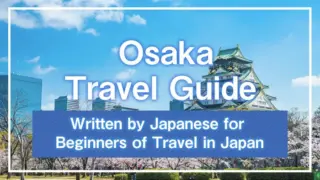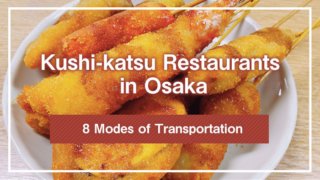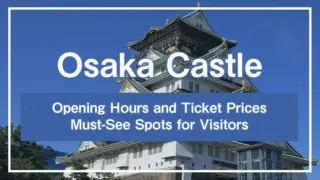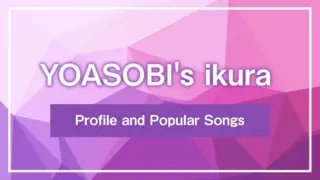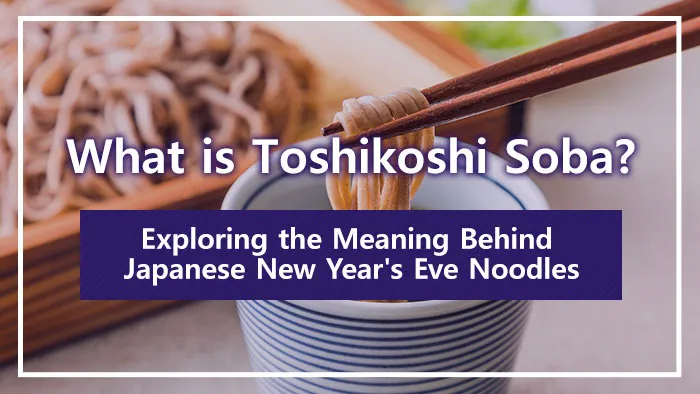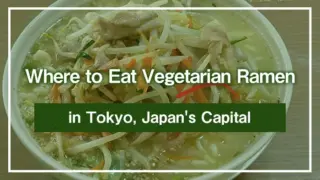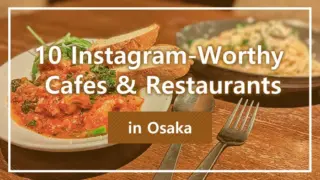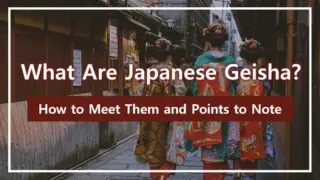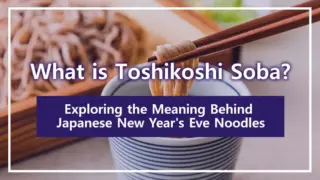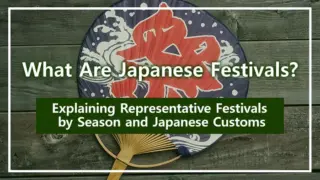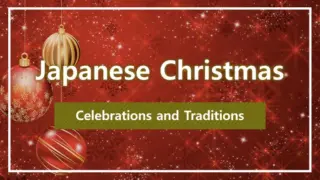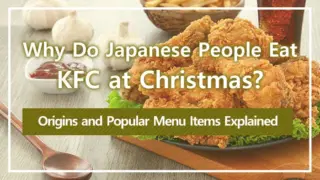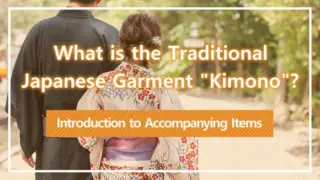Toshikoshi Soba is one of the food cultures that symbolizes the Japanese year-end, widely cherished as special soba noodles eaten on New Year’s Eve. Its origins date back to the Edo period, embodying the meaning of “cutting away the year’s misfortunes and wishing for happiness in the new year.” Today, it is served not only at homes but also at soba restaurants and temples, establishing itself as a traditional year-end custom.
This article introduces the significance of Toshikoshi Soba eaten at year-end in Japan and regional variations. If you’re spending the New Year season in Japan, please use this article as a reference and savor Toshikoshi Soba.
1. What is Toshikoshi Soba
Toshikoshi Soba refers to special soba noodles eaten on New Year’s Eve in Japan, cherished as “a lucky food to cut away misfortunes at the year’s end and wish for good fortune and longevity.” While soba is eaten throughout the year as a traditional Japanese food, soba on New Year’s Eve holds special meaning.
Today, many Japanese people enjoy Toshikoshi Soba at home or at soba restaurants. With differences in seasoning and toppings by region, it has become a popular event for foreign tourists as part of year-end food culture.
1-1. History of Toshikoshi Soba
The origins of Toshikoshi Soba have various theories, but it is said that during the Edo period, the culture of “eating soba at year’s end to cast away misfortunes” became established among merchants and common people. After the Meiji period, it spread nationwide, and today it is said that about 60% of households eat soba on New Year’s Eve.
This tradition has been passed down through the ages and now gathers popularity among visitors from overseas as a food culture symbolizing Japan’s year-end.
1-2. Meaning of Toshikoshi Soba
Toshikoshi Soba carries four symbolic meanings: “longevity,” “warding off evil,” “financial fortune,” and “renewal.”
First, the thin, long noodles embody wishes for “long life” and “good health,” while their tendency to break easily symbolizes “cutting away disasters.” Furthermore, because gold craftsmen once used buckwheat flour to collect gold dust, the dish also carries the auspicious meaning of “inviting wealth.”
Additionally, since buckwheat is resilient to wind and rain and sprouts again, it also represents “rising again without succumbing to difficulties.” During the Edo period, it was also called “debt-cutting soba,” embodying wishes for welcoming a positive new year.
Toshikoshi Soba is not merely a meal but carries various meanings “to conclude the year with gratitude and welcome the new year with purity.”
1-3. When to Eat Toshikoshi Soba
While there are no strict rules about when to eat Toshikoshi Soba, it is generally considered best to finish eating before midnight on December 31st. This is because of the meaning of “not carrying the old year’s misfortunes into the new year.”
Many households eat soba together as dinner with family, or conclude the year with a bowl of soba before hearing the temple bells on New Year’s Eve. Also, since soba is easily digestible and suitable for late-night meals, many people enjoy warm soba after returning from temple bells or first shrine visits of the new year.
Whether at home or at restaurants, being mindful to finish eating within the old year preserves the meaning of Toshikoshi Soba.
2. Variations of Toshikoshi Soba
Toshikoshi Soba has diverse variations depending on region and household. By freely arranging ingredients, broth, and temperature with the basic soba, both taste and auspiciousness change. While cherishing tradition, the appeal lies in being able to choose according to family preferences and that year’s mood.
Here, we explain variations of Toshikoshi Soba in detail.
2-1. Should Toshikoshi Soba Be Hot or Cold?
Toshikoshi Soba comes in both “hot soba” and “cold soba,” and while the choice is free, “hot soba” that warms the body during the cold season is generally more popular. Hot soba spreads the aroma of dashi and the umami of the broth, pairing excellently with ingredients like shrimp tempura and green onions. In the Kanto region, darker soy sauce flavor is mainstream, while in the Kansai region, light soy sauce dashi is prevalent, with flavors differing by region.
On the other hand, “cold soba” is also popular. Its appeal lies in smooth texture and enjoying soba’s original aroma, suitable for those who want to eat refreshingly during the busy year-end period. Particularly in regions with thriving soba culture like Hokkaido and Niigata, many households conclude the year with cold soba.
Either choice doesn’t change the auspiciousness or meaning. Enjoying it in a way that allows you and your family to feel comfortable is most important.
2-2. Main Toppings for Toshikoshi Soba
The appeal of Toshikoshi Soba lies in the “good fortune” embedded in ingredients.The most standard is shrimp tempura, symbolizing longevity with the meaning “living long enough for one’s back to bend.” The red color also represents celebration, creating a festive bowl.
Kamaboko symbolizes celebratory occasions with its red and white coloring, expressing joy in welcoming the new year. Green onions are cherished through wordplay meaning “to reward the year’s labor” and are indispensable as condiments. Fried tofu is considered a lucky food associated with foxes, messengers of Inari deities, wishing for business prosperity and abundant harvests.
Each ingredient is characterized by special meanings embodying wishes for happiness in the new year.
3. Types of Toshikoshi Soba Commonly Eaten Throughout Japan
Throughout Japan, diverse Toshikoshi Soba adapted to regional climate and food culture is cherished. The ingredients used, dashi, and eating methods differ, characterized by experiencing each region’s individuality and history. Tasting a unique bowl in your travel destination is one of the appeals of experiencing Japanese culture.
Here, we introduce Toshikoshi Soba from various parts of Japan.
3-1. Nishin Soba (Hokkaido/Kyoto)
“Nishin Soba” is one of the representative Toshikoshi Soba of Kyoto and Hokkaido.It is a traditional bowl featuring herring (dried herring) simmered in sweet-savory sauce atop kake soba, characterized by refined flavor harmonizing fish umami with soba’s aroma.
In Kyoto, soba using dried herring was devised during the Meiji period, establishing itself as Kyoto cuisine prepared with elegant light-colored dashi. Meanwhile, in Hokkaido, as a herring production area, seasoning using dark soy sauce is mainstream, offering a more robust flavor.
Herring is also known as a lucky ingredient symbolizing “prosperity of descendants” through wordplay with “nishin (two parents).” It is a Toshikoshi Soba filled with tradition and wishes, suitable for eating before the New Year.
3-2. Wanko Soba (Iwate Prefecture)
Iwate Prefecture’s specialty “Wanko Soba” is soba with a unique style where bite-sized portions are continuously poured into small bowls while eating. Its origins trace back about 400 years, said to have originally been cuisine for entertaining feudal lords.
The scene where servers add soba to bowls while calling out “Dondon!” is one of the food cultures representing the Tohoku region. On New Year’s Eve, there is a custom that “eating as many bowls of Wanko Soba as your age brings longevity,” also cherished as a lucky food.
The noodles are cut shorter than usual, with smooth texture designed to allow eating many bowls. It is a traditional dish popular with tourists as soba where eating itself is enjoyable.
3-3. Hegi Soba (Niigata Prefecture)
Niigata Prefecture’s “Hegi Soba” is distinctive soba made using “funori,” a type of seaweed, as a binding agent. Originating from the Uonuma region, it is characterized by beautifully arranging bite-sized bundles of soba in a square wooden container called “hegi.”
The appeal lies in the slippery texture and strong elasticity created by funori’s stickiness, allowing enjoyment of a texture different from regular soba. Often served cold, it allows thorough savoring of soba’s original aroma and texture.
It is a regional soba representing Niigata, served not only as Toshikoshi Soba but also at ceremonial occasions and celebrations.
3-4. Echizen Oroshi Soba (Fukui Prefecture)
Fukui Prefecture’s “Echizen Oroshi Soba” is a regional dish characterized by refreshing taste with generous grated daikon radish. A traditional food inherited from the Edo period, it is enjoyed by grating spicy daikon and adding dashi or raw soy sauce.
Fukui’s soba features somewhat dark, thick noodles with firm texture and strong aroma. Adding green onions and bonito flakes as condiments creates a more flavorful finish. The appeal also lies in grated daikon aiding digestion and providing a refreshing aftertaste.
It also carries the meaning of preparing the body before welcoming the new year, embodying the wish to “purify mind and body to welcome the new year.” It is Fukui-style Toshikoshi Soba with simple yet profound flavor.
Conclusion
Toshikoshi Soba is a lucky food eaten with wishes for “longevity,” “warding off evil,” “financial fortune,” and “renewal.” The thin, long noodles embody wishes for health and long life, while their tendency to break symbolizes cutting away the year’s misfortunes. While there are no strict rules about eating time, finishing within the old year is common, carrying meaning of welcoming the new year with purity.
Regional flavors and toppings also have distinctive characteristics, with as many memorable Toshikoshi Soba as there are households. The moment of savoring soba on New Year’s Eve is an important Japanese custom connecting gratitude for the past year with hope for the new year beginning.
*This article is based on information available as of October 2025.

